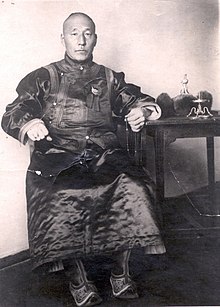Chatanbaatar Magsardschaw
Chatanbaatar Magsardschaw ( Mongolian Хатанбаатар Магсаржав , "Fixed Hero" Magsardschaw or Сандагдоржийн Магсаржав , Sandagdordschiin Magsardschaw * 1878 , † 1927 ) was a general in the battle of Mongolia for independence, and in 1921 a few months Mongolian Prime Minister . In 1924 he received the additional honorary title Ardyn Chatanbaatar Magsardschaw ( Mongolian Ардын Хатанбаатар Магсаржав , fixed hero of the Magsardschaw people ).
Magsardschaw supported the autonomy movement in Mongolia after the Chinese revolution in 1912. As titular duke he was lieutenant general of the deputy military governor of Kobdo , P'u-jun , who opposed the independence of Mongolia. He refused to leave Kobdo even after Magsardschaw had sent him a letter from the Mongolian government in Urga , in which they asked him to do so. Magsardschaw initially wanted to resolve the conflict non-violently. But after learning of a planned attack on him, he secretly went to Urga. Together with Jamtsangiin Damdinsüren , he became a “dignitary for pacifying the western border” in May 1912 and moved to Kobdo with army contingents. This they captured in August 1912, after fighting a Chinese army that had drawn up from Xinjiang and a long siege of the city. According to the biography of the politician Khorloogiin Choibalsan , Magsardschaw is said to have consecrated the Mongolian standard with the heart of an enemy during this siege. As a reward for his activities during the struggle for Kobdo, Magardjaw received the title Qatan Bayatur and became duke, deputy interior minister and master of ceremonies.
After the Chinese invaded again, Magsardschaw was arrested in 1919, but later liberated during the Baron von Ungern-Sternberg's campaign . From February 15 to March 1921 he was Prime Minister of Mongolia under von Ungern-Sternberg's terror regime. He died in 1927.
literature
- Michael Weiers (ed.): The Mongols: Contributions to their culture and history. Wissenschaftliche Buchgesellschaft, Darmstadt 1986, pp. 485-86, 493, ISBN 3-534-03579-8
| personal data | |
|---|---|
| SURNAME | Chatanbaatar, Magardjaw |
| ALTERNATIVE NAMES | Magsardschaw, Sandagdorsch; Ардын Хатанбаатар Магсаржав; Магсаржав, Сандагдорж (Mongolian) |
| BRIEF DESCRIPTION | Mongolian Prime Minister |
| DATE OF BIRTH | 1878 |
| DATE OF DEATH | 1927 |
